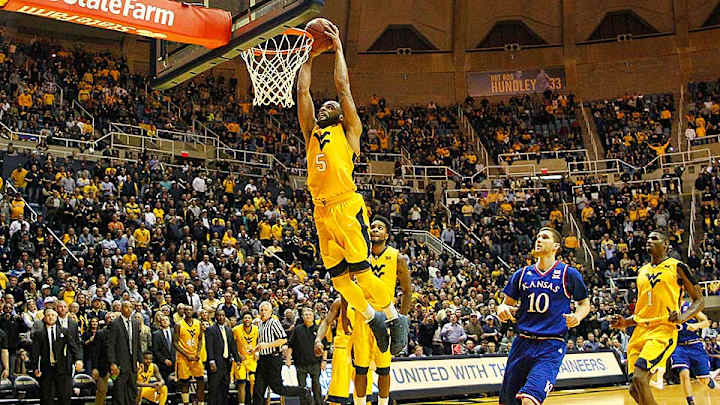Suffocating press defense helps No. 11 West Virginia upset No. 1 Kansas

Kansas’s spot atop college basketball will be short-lived. A week and a day after being named No. 1 in the AP poll and then beating No. 2 Oklahoma in triple-overtime, the Jayhawks fell on the road, 74–63, to West Virginia. Here are three thoughts on the game, and what it means for the Big 12 and college basketball as a whole as conference play heats up:
“Press” Virginia is legit
This wasn’t a monumental upset. West Virginia came into the game as the No. 10 team in adjusted efficiency on kenpom.com, and the site also gave the Mountaineers a 49% chance of a win against the Jayhawks. The Mountaineers’ sole loss this season was at Madison Square Garden to Virginia on Dec. 8; since that game, they’ve beaten opponents by an average of 18.6 points per game. The key continues to be the press defense that Bob Huggins installed just weeks before the 2014–15 season. It helped West Virginia’s defense go from 154th in adjusted defensive efficiency in 2013–14 to 45th that year. This season, the Mountaineers are pressing on 39.8% of their possessions and have the fourth-most efficient defense in college basketball. They also lead the country in defensive turnover percentage and steal percentage.
• WATCH: Jonathan Holton rejects Perry Ellis at the rim
Kansas came into the game averaging 11.5 turnovers per contest and featuring three of the best guards in the country in juniors Wayne Selden Jr. and Frank Mason III and sophomore Devonte’ Graham. Selden Jr. and Mason III combined for 13 turnovers, and the Jayhawks committed 22 as a team. Because of foul trouble and turnover issues, Kansas coach Bill Self actually gave minutes to 13 players against West Virginia. Remarkably, the Mountaineers’ bench, bolstered by 26 points from guard Jaysean Paige, managed to outscore the Jayhawks’, 40–10. The Mountaineers still have some significant flaws—they’re No. 279 in the country in three-point percentage and only shot 25% from downtown and 33.3% from the floor against Kansas—but their defense is more than enough for them to challenge for a Big 12 title and to be the team no one wants to see in March.
There are no nights off in the Big 12
The Big 12 has 10 teams. Nine of them are in kenpom.com’s top 100. Seven are in the top 50. Three—Kansas, Oklahoma and now West Virginia—are in the top five. So unless you’re hosting TCU, there aren’t any gimmies in this conference. And the beauty of the Big 12 is that it’s the only major conference that still plays a true double round-robin, which means that we’ll get to witness the Jayhawks try to exact revenge on West Virginia in Allen Fieldhouse on Feb. 9.
Bubble Watch: Pac-12 could send nine teams to the NCAA tournament
And although the Big 12 posted an impressive 96–20 (82.8%) record in the nonconference months of November and December, there will be another chance to evaluate its best teams against top-flight competition at the Big 12/SEC Challenge. On Jan. 30, among other games, we’ll see Oklahoma travel to LSU (Ben Simmons vs. Buddy Hield, anybody?) and Kansas host Kentucky. The Big 12 is ranked No. 1 in RPI, which should help boost its bubble teams’ hopes.
In his first Bracket Watch of the season, SI’s Michael Beller put seven Big 12 teams—the three mentioned above and Iowa State, Baylor, Texas Tech and Texas—into the Big Dance. The important thing for the conference now is that it doesn’t beat itself up too badly during the regular season and league tournament so that it can avoid another embarrassing NCAA tournament. Last season, The Big 12 put six teams into the NCAA tournament. Only two made it to the second weekend, and none qualified for the Elite Eight.
State of the Union
Another No. 1 bites the dust. North Carolina entered the season on top in the nation, but only lasted two weeks. Kentucky took over but couldn’t make it past two weeks either. Then it was Michigan State for four weeks. Kansas is starting its second week but is unlikely to remain on top after this loss. Maybe Oklahoma (No. 2) will become the fifth top team this season, or maybe Michigan State will reclaim this spot. Either way, this much is clear: There is no dominant team this season. Last year, Kentucky’s pursuit of perfection dominated the national conversation. This season, only two teams remain undefeated—and only one of them, South Carolina, even has a shot at 40–0. (SMU is ineligible for the postseason.)
• DAVIS: Winners and losers from the nonconference season
It’s true that college basketball teams are not as good as they were last year. Current No. 1 Villanova boasts a 95.43 Pythagorean winning percentage, which measures how likely a team is to beat an average D-I team. That would have been good for No. 4 last year. And only this year’s four top teams would have been able to fit into last year’s top 10. While we may not be witnessing the elite level of basketball Kentucky, Arizona, Wisconsin and Duke were putting on last year, the increased competition makes each night more fun to watch. You never know how long No. 1 is going to last.
